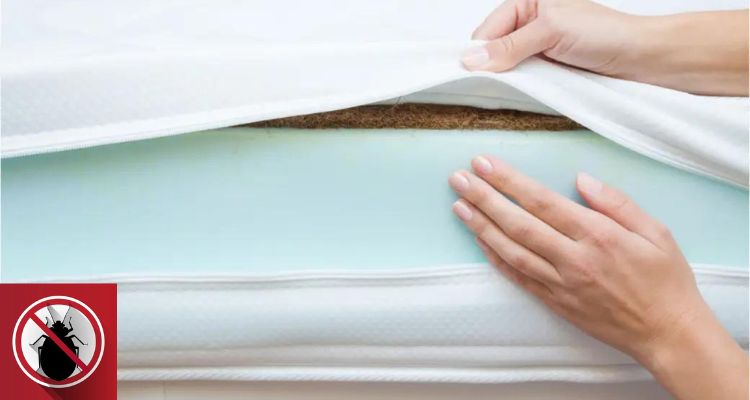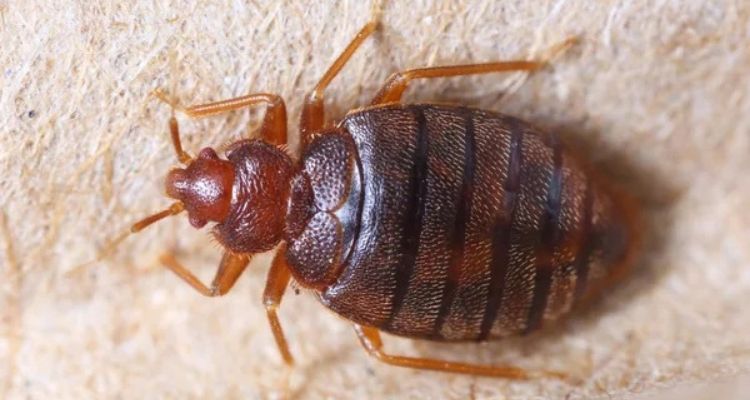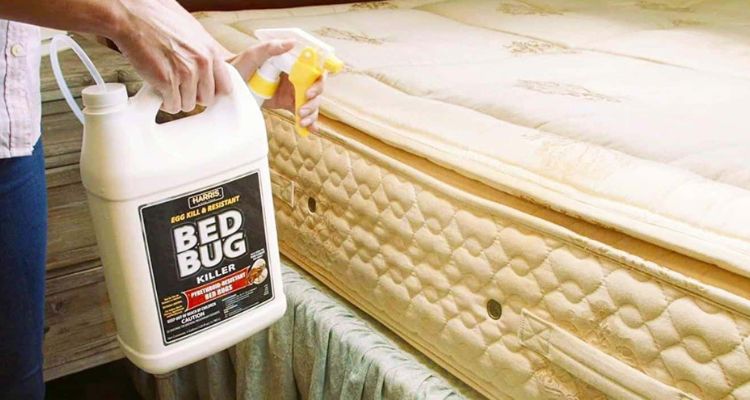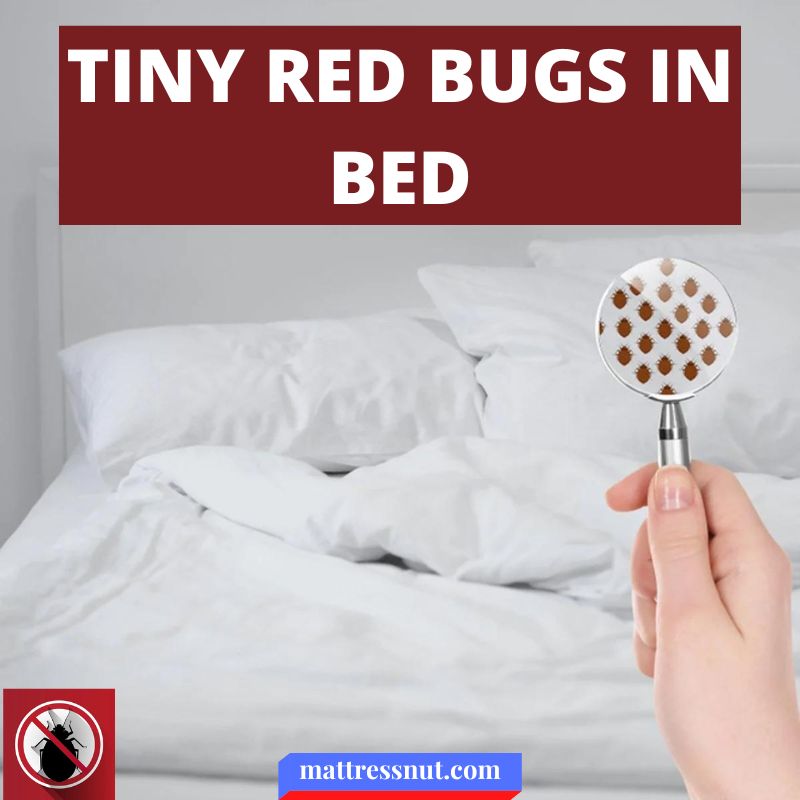Wherever we live, so many other creatures live around us. For example, there will be flies, honey bees, and other insects wherever there is a garden. Where there is water or swamp, there will be mosquitoes, etc. Similarly, some tiny creatures live on your bed, mattress, or bedding. Most common are the bed bugs, in particular, red bugs. In this article, we will find out what are red bed bugs and how to get rid of them.
Ultimately, you’ll know how to fight them and protect your home from future attacks. So, let’s get to it.
What Are Tiny Red Bugs in Bed?
There is not an easy way to find out what exactly the red bugs in your bed are. So, the question is, why is that? The answer is that different types of bugs can come crawling on your bed.

Identifying what kind of red bug is in your bed is difficult. In some instances, those red bugs might be clover mites that are not all-season bed bugs. There main season of attack is early summer or late spring. These bed bugs don’t prefer an inside environment as their food source is outside, that is, your garden. In particular, if you have grown clover in your garden, there is a more chance of clover mites visiting you during their season.
If clover mites like outdoors, why do they come to beds? The answer is that they move inside when there is a change in the weather, like extreme heat or torrential rain. They don’t feed on your blood or carry any transmitting disease. They put nasty stains on the beds, beddings, furniture, or walls.
The other type of bed bug is dangerous, as their main food source is your blood. These tiny creatures are brownish at first, but after a blood-sucking session, they appear as reddish, hence red bugs.
The time of the attack of these bed bugs is at night when you are soundly sleeping. First, they will crawl on your exposed skin, pierce their beaks, and suck the blood. This piercing is so precise that you don’t notice it while it is happening. This blood-sucking lasts for 3 to 10 minutes; after that, they crawl back to their bases.
What Do Tiny Red Bugs in Bed Look Like?
One thing is for sure, they all are tiny and hence difficult to differ. Another thing which is common among them is their red color. However, in the case of bed bugs, it’s more of a reddish-brown color. The overall structure of all the bed bugs is unique.

In the case of clover mites, they are red. These oval-shaped bugs belong to the family of arachnids and are less than 1mm long. The overall structure comprises eight legs. The rare two legs are slightly longer than the middle four legs. However, their most prominent structure is their front legs. These legs are larger than the rest, and near the head, so mostly, these are mistaken for antennas. As they feed on grass, flowers, and leaves, long front legs are essential for better grabbing and reach.
Unlike clover mites, bed bugs look like tiny cockroaches as they are oval. These reddish-brown bugs are only one-quarter of an inch long. The upper surface of the bugs looks like they have feathers, but on the contrary. They have six legs in total and short antenna-like limbs near the mouth. Their tinny size makes them hard to look at with a naked eye. You might need a magnifying glass to identify them.
Another type is chiggers. These bugs are the tinniest of all. With only 1/150th of an inch, they cannot be seen without a magnifying glass. The overall shape of these bugs is more like a spider. Most of the time, they attack in clusters, and it is easy to identify them in that stage. With 8 legs placed along the body, these mites resemble a spider. The front of the face is like a beak, similar to a spider.
Are Red Bugs on The Bed Dangerous?
Not all bed bugs in red are dangerous. However, most of them survive on blood, so they can give you itchy skin or, in worst cases, skin-related disease. It is essential to know the type of bug in your bed because if it’s venomous, you need the proper antigen.
If you find clover mites in your bed, don’t worry about any damage to your health. The only source of their food is flowers, grass, and clover in your garden. Therefore, there is no chance that they carry any virus or other diseases with them. However, they will stink your bedding, furniture, and walls with stains. So, if you smash them, get ready to get a spot on your bed.
Unlike clover mites, red bedbugs have a different story. These bugs survive on the host’s blood, mainly humans. The bites of bed bugs are usually in symmetry in a row. These bites leave the skin with red bumps, just like mosquito bites. These red bumps are incredibly itchy. Although these bugs don’t transmit any disease, the extreme itch can lead to broken skin.
In some cases, the broken skin can get infected otherwise. If your immunity is not too strong, you might get an allergic reaction from the bites of bedbugs. If this happens, consult your doctor for an anti-allergic treatment.
Clover Mites Vs Bed Bugs
Generally, people only know that their beds are infested with bugs. Knowing the difference is important for detection, prevention, and protection.
When it comes to clover mites, they are born red. However, the bed bugs are brown originally but become reddish-brown after having the blood meal.
Clover mites have eight legs to support their oval shape, while bedbugs need eight legs to carry their flat body. The front legs of the clover mites are longer than the rest of the legs. These are closer to the mouth and resemble an antenna. The bedbugs have a beak-like mouth which they prick on the skin for suction.
Clover mites survive on plants, while bedbugs survive on blood. Therefore, clover mites don’t bite humans, while bedbugs can’t survive without biting humans.
Getting rid of clover mites is not difficult, but they leave stains. However, that is not the case with bedbugs. It’s difficult and expensive to find and eliminate bedbugs. You might need to buy specialized sprays to kill bedbugs. In some cases, you might need the professional help of exterminators.
Clover mites only come inside when there is extreme weather outside, like high heat or heavy rain. On the other hand, bedbugs will settle in your home until you counter-attack. Clover mites have a limited life span of 2 – 3 weeks, while bedbugs can survive for 3 to 4 months.
How Do They Get into Bed?
You don’t have to worry about clover mites as they don’t like to be inside. They prey on plants and can’t survive without the other. The only way they are inside your room is the weather outside is hard. So, why are they still on your bed? It is just by mistake. A clover mite finds a crack in your wall or window and accidentally enters your room.
That is not the case with bedbugs. Once they access your room, they will invade your area and won’t go easily. Usually, they transfer from one infested area to another. You might have visited your friend’s house who has these bedbugs in their house. Now you have the bedbug problem yourself. Once they are transferred, they will find hidden areas near your bed, like cracks or crevices.
How To Get Rid of These Bed Bugs?
If your bed is infested with any bed bugs, it is important to take measures to get rid of them. For some bugs, you can do home remedies or thorough cleaning. For other types, you might need professional help.
Following are some of the ways we can get rid of bed bugs:
Vacuum Your Bed
The easiest way to get rid of bed bugs, particularly clover mites, is by thoroughly vacuuming. Make sure you vacuum not just your bed but also your bedding, mattress base, base head, and the area surrounding your bed. After vacuuming, throw the vacuum bag far away from your house, so the bed bugs don’t come crawling back. After that, wash your sheets with bleach detergent to kill any remaining bugs.
Keep in mind not to smash clover mites because that will stain your room badly.
Freeze Them to Oblivion
All the bed bugs can only survive in a particular weather condition. For example, clover mites cannot survive extreme heat or cold weather. Similarly, other bed bugs cannot survive high temperatures. Another way of dealing with bed bugs is to place your sheets in a freezer, put the freezer on 0°C and let your sheet be there for at least 4 days. No bed bug will survive this temperature. In other words, “Freeze Them to Oblivion.”
Use Sticky Tape & Crank Up the Heat
You can also give a heat treatment to the bed bugs. Place some sticky tape on your mattress, bedding, and the surrounding area for the night. Once the bed bugs are out for the feast, they will get stuck on the sticky tape. In the morning, put your bedding and clothes in hot water and wash. After that, heat dry your sheets and cloths for not less than 30 minutes at the highest temperature setting. The high temperature will kill the bugs.
For your mattress, steam it using a steamer (check the 5 amazing steam cleaners for mattress). If the weather outside is hot, put all the infested fabric in a bag and place it for the maximum kill.
Spray Insecticides
Another way to get rid of bed bugs is by using insecticides. Before selecting any insecticide, make sure you know how to use that, so it doesn’t become harmful to you or your family. Moreover, choosing the environmentally friendly one is approved by U.S. Environmental Protection Agency. Some bugs become immune to certain insecticides. In that case, it is better to consult a professional before buying the chemical yourself.

Remove Plants & Shrubs in Close Periphery
Removing extra plants and shrubs close to your windows or door is a preventive measure against bed bugs. This technique is effective against clover mites. Clover mites exist in plants, and they hardly move on dry land. You can prevent these bugs from entering your area by cutting the transfer source.
How To Spot Tiny Red Bugs in The House and Outdoors?
It is difficult to identify a tiny red bug around you because of its small size. So, how to spot them then? The clover mites only survive on plants, flowers, and fruits, and mostly they will remain outside.
So, if you suspect any infestation, the easiest way to find out about these red bugs is to smash some leaves from your garden. If you find red spots after that, it is confirmed that these are clover mites. If not, and you still suspect an infestation, seek help from professionals to treat the surrounding area of your house properly.
The same goes for inside your house. For example, if your inside plant is eaten and you find red spots upon smashing, it is the clover mites. Similarly, if you see a red insect on your bed, and you smash it, and the area becomes red, your mattress is infested with bed bugs. Again, this will leave a nasty stain that is hard to clean.
Key Takeaways: Tiny Red Bugs In Bed & How To Handle Them
Wherever we live, creatures surround us, from the honey bees buzzing in our gardens to the diverse insects near water sources. Our homes are no exception, with various tiny bugs finding their way into our bedding. Notably, red bed bugs are a common culprit. In this guide, you’ll discover how to identify these pests and eliminate them, ensuring a bug-free night’s sleep.
Identifying the Culprit
While your initial thought might be bed bugs, many types of red bugs can be present in beds. Clover mites, for instance, are seasonal invaders primarily active in early summer or late spring. Although they’re outdoor bugs feeding on garden plants like clover, they might migrate indoors during extreme weather conditions. Unlike some pests, they don’t feed on human blood and are relatively harmless, although they can leave unsightly stains on bedding and walls.
Danger Level: Are They Harmful?
Not all tiny red bed bugs pose a risk to humans. For instance, clover mites feed on plants and don’t transmit diseases. However, they can leave unsightly stains on surfaces. Contrastingly, red bedbugs rely on human blood. Their bites, often in a row, cause itchy, red bumps reminiscent of mosquito bites. While they don’t spread diseases, excessive itching can break the skin, potentially leading to secondary infections.
Spotting the Difference: Clover Mites Vs. Bed Bugs
At a glance, it might be hard to differentiate between clover mites and bed bugs. Clover mites, naturally red, have eight legs with the front pair resembling antennas. These mites feed on plants. Bed bugs, on the other hand, are reddish-brown post feeding and have six legs. They’re blood feeders, which means they bite humans for sustenance.
Entry Points: How Do They Invade Beds?
Clover mites primarily invade homes unintentionally, typically driven indoors by extreme weather. They might enter through cracks or gaps in the house structure. Bed bugs are more insidious. They often hitch a ride on luggage, clothes, or used furniture, transferring from one infested location to another.
Eliminating the Pests
There are multiple strategies to rid your bed of these bugs. Vacuuming can be effective, especially for clover mites. Beddings can be frozen or heated to exterminate the bugs. Additionally, specific insecticides, preferably eco-friendly and EPA-approved, can be applied. For stubborn infestations, professional extermination might be necessary.
Prevention: Keeping Them Away
Spotting tiny red bugs indoors or in the garden can be challenging due to their minute size. For those in the garden, crushing a leaf could reveal red stains indicating a clover mite presence. Indoors, if squashing a bug leaves a red mark, you’re likely dealing with bed bugs. Regularly inspecting and cleaning your home, reducing clutter, and sealing entry points are essential preventive measures.
Conclusion
Bed mites are not an uncommon problem. Most probably, if you have a garden in the surrounding area of your house. But there is nothing to be afraid of, as these mites do not carry any virus or disease apart from itching. Further, it is easy to control this problem and take preventive measures. After reading this article, you will know the implications and the prevention techniques if you ever face this problem.
Tiny red bugs in bed FAQs
Are Red Mites Harmful to Humans?
It depends upon the type of red bugs. If it is clover mite, it is not harmful to humans. Although annoying. However, if it's bedbugs or chiggers, they will leave red bumps over your skin from where they have sucked the blood. Those bumps are itchy and can lead to skin break and allergic reactions.
What To Do If You Slept in A Bed with Bed Bugs?
If you find red bumps itchy, use some oil or ointment to reduce the itch. If your skin is sensitive, consult your doctor. After that, wash your sheets and clothes in hot water and dry them at high heat for 30 minutes. Next, vacuum the surrounding area and throw the waste bag far away from your house. Finally, stream treat your mattress, sofas, and anything with fabric or fur.
What Kills Little Red Mites Instantly?
Insecticides will kill red mites instantly. Make sure those insecticides are registered with U.S. Environmental Protection Agency. Extreme heat and cold treatment kill these red mites in no time.
How Do You Get Rid of Red Mites on Humans?
The best way is to take a shower. Put some hot water in your bathtub, make the water super soapy and trench your body in it. Next, use a clean washcloth to scrub your skin. This way, you can get rid of any mites on your body. If you have itching on the affected area, take some anti-allergy medication.

